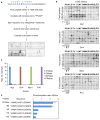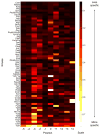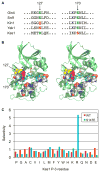Deciphering protein kinase specificity through large-scale analysis of yeast phosphorylation site motifs
- PMID: 20159853
- PMCID: PMC2846625
- DOI: 10.1126/scisignal.2000482
Deciphering protein kinase specificity through large-scale analysis of yeast phosphorylation site motifs
Abstract
Phosphorylation is a universal mechanism for regulating cell behavior in eukaryotes. Although protein kinases target short linear sequence motifs on their substrates, the rules for kinase substrate recognition are not completely understood. We used a rapid peptide screening approach to determine consensus phosphorylation site motifs targeted by 61 of the 122 kinases in Saccharomyces cerevisiae. By correlating these motifs with kinase primary sequence, we uncovered previously unappreciated rules for determining specificity within the kinase family, including a residue determining P-3 arginine specificity among members of the CMGC [CDK (cyclin-dependent kinase), MAPK (mitogen-activated protein kinase), GSK (glycogen synthase kinase), and CDK-like] group of kinases. Furthermore, computational scanning of the yeast proteome enabled the prediction of thousands of new kinase-substrate relationships. We experimentally verified several candidate substrates of the Prk1 family of kinases in vitro and in vivo and identified a protein substrate of the kinase Vhs1. Together, these results elucidate how kinase catalytic domains recognize their phosphorylation targets and suggest general avenues for the identification of previously unknown kinase substrates across eukaryotes.
Conflict of interest statement
Competing interests: M.S. consults for Affomix, which has an interest in proteomics, including phosphoproteomics.
Figures






References
-
- Manning G, Plowman GD, Hunter T, Sudarsanam S. Evolution of protein kinase signaling from yeast to man. Trends Biochem Sci. 2002;27:514–520. - PubMed
-
- Moffat J, Sabatini DM. Building mammalian signalling pathways with RNAi screens. Nat Rev Mol Cell Biol. 2006;7:177–187. - PubMed
-
- Schmelzle K, White FM. Phosphoproteomic approaches to elucidate cellular signaling networks. Curr Opin Biotechnol. 2006;17:406–414. - PubMed
-
- Ptacek J, Devgan G, Michaud G, Zhu H, Zhu X, Fasolo J, Guo H, Jona G, Breitkreutz A, Sopko R, McCartney RR, Schmidt MC, Rachidi N, Lee SJ, Mah AS, Meng L, Stark MJ, Stern DF, De Virgilio C, Tyers M, Andrews B, Gerstein M, Schweitzer B, Predki PF, Snyder M. Global analysis of protein phosphorylation in yeast. Nature. 2005;438:679–684. - PubMed
-
- Elphick LM, Lee SE, Gouverneur V, Mann DJ. Using chemical genetics and ATP analogues to dissect protein kinase function. ACS Chem Biol. 2007;2:299–314. - PubMed
Publication types
MeSH terms
Substances
Grants and funding
LinkOut - more resources
Full Text Sources
Other Literature Sources
Molecular Biology Databases
Research Materials

